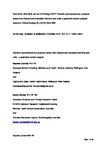Intensive care bereavement practices across New Zealand and Australian intensive care units: a qualitative content analysis.
| dc.contributor.author | Coombs, M | en |
| dc.contributor.author | Mitchell, M | en |
| dc.contributor.author | James, S | en |
| dc.contributor.author | Wetzig, K | en |
| dc.date.accessioned | 2018-12-16T12:02:57Z | |
| dc.date.available | 2018-12-16T12:02:57Z | |
| dc.date.issued | 2017-10 | en |
| dc.identifier.uri | http://hdl.handle.net/10026.1/13040 | |
| dc.description.abstract |
BACKGROUND: End-of-life and bereavement care is an important consideration in intensive care. This study describes the type of bereavement care provided in intensive care units across Australia and New Zealand. DESIGN: Inductive qualitative content analysis was conducted on free-text responses to a web-based survey exploring unit-based bereavement practice distributed to nurse managers in 229 intensive care units in New Zealand and Australia. RESULTS: A total of 153 (67%) surveys were returned with 68 respondents making free-text responses. Respondents were mainly Australian (n = 54, 85·3%), from the public sector (n = 51, 75%) and holding Nurse Unit Managers/Charge Nurse roles (n = 39, 52·9%). From the 124 free-text responses, a total of 187 individual codes were identified focussing on bereavement care practices (n = 145, 77·5%), educational provision to support staff (n = 15, 8%) and organisational challenges (n = 27, 14·4%). Bereavement care practices described use of memory boxes, cultural specificity, annual memorial services and use of community support services. Educational provision identified local in-service programmes, and national bereavement courses for specialist bereavement nurse coordinators. Organisational challenges focussed on lack of funding, especially for provision of bereavement follow-up. CONCLUSIONS: This is the first Australasian-wide survey, and one of the few international studies, describing bereavement practices within intensive care, an important aspect of nursing practice. However, with funding for new bereavement services and education for staff lacking, there are continued challenges in developing bereavement care. Given knowledge about the impact of these areas of care on bereaved family members, this requires review. RELEVANCE TO CLINICAL PRACTICE: Nurses remain committed to supporting bereaved families during and following death in intensive care. With limited resource to support bereavement care, intensive care nurses undertake a range of bereavement care practices at time of death, and after death through family bereavement follow-up. | en |
| dc.format.extent | 2944 - 2952 | en |
| dc.language | eng | en |
| dc.language.iso | eng | en |
| dc.rights | Attribution-NonCommercial-NoDerivatives 4.0 International | en |
| dc.rights | Attribution-NonCommercial-NoDerivatives 4.0 International | en |
| dc.rights | Attribution-NonCommercial-NoDerivatives 4.0 International | en |
| dc.rights | Attribution-NonCommercial-NoDerivatives 4.0 International | en |
| dc.rights | Attribution-NonCommercial-NoDerivatives 4.0 International | en |
| dc.rights | Attribution-NonCommercial-NoDerivatives 4.0 International | en |
| dc.rights.uri | http://creativecommons.org/licenses/by-nc-nd/4.0/ | en |
| dc.rights.uri | http://creativecommons.org/licenses/by-nc-nd/4.0/ | en |
| dc.rights.uri | http://creativecommons.org/licenses/by-nc-nd/4.0/ | en |
| dc.rights.uri | http://creativecommons.org/licenses/by-nc-nd/4.0/ | en |
| dc.rights.uri | http://creativecommons.org/licenses/by-nc-nd/4.0/ | en |
| dc.rights.uri | http://creativecommons.org/licenses/by-nc-nd/4.0/ | en |
| dc.subject | bereavement | en |
| dc.subject | death | en |
| dc.subject | dying | en |
| dc.subject | end-of-life care | en |
| dc.subject | family | en |
| dc.subject | intensive care | en |
| dc.subject | nursing role | en |
| dc.subject | Adult | en |
| dc.subject | Australia | en |
| dc.subject | Bereavement | en |
| dc.subject | Child | en |
| dc.subject | Critical Care Nursing | en |
| dc.subject | Female | en |
| dc.subject | Humans | en |
| dc.subject | Intensive Care Units | en |
| dc.subject | Internet | en |
| dc.subject | Male | en |
| dc.subject | New Zealand | en |
| dc.subject | Patient-Centered Care | en |
| dc.subject | Practice Patterns, Nurses' | en |
| dc.subject | Surveys and Questionnaires | en |
| dc.title | Intensive care bereavement practices across New Zealand and Australian intensive care units: a qualitative content analysis. | en |
| dc.type | Journal Article | |
| plymouth.author-url | https://www.ncbi.nlm.nih.gov/pubmed/27808455 | en |
| plymouth.issue | 19-20 | en |
| plymouth.volume | 26 | en |
| plymouth.publication-status | Published | en |
| plymouth.journal | J Clin Nurs | en |
| dc.identifier.doi | 10.1111/jocn.13624 | en |
| plymouth.organisational-group | /Plymouth | |
| plymouth.organisational-group | /Plymouth/REF 2021 Researchers by UoA | |
| plymouth.organisational-group | /Plymouth/REF 2021 Researchers by UoA/UoA03 Allied Health Professions, Dentistry, Nursing and Pharmacy | |
| dc.publisher.place | England | en |
| dcterms.dateAccepted | 2016-10-27 | en |
| dc.identifier.eissn | 1365-2702 | en |
| dc.rights.embargoperiod | Not known | en |
| rioxxterms.versionofrecord | 10.1111/jocn.13624 | en |
| rioxxterms.licenseref.uri | http://creativecommons.org/licenses/by-nc-nd/4.0/ | en |
| rioxxterms.licenseref.startdate | 2017-10 | en |
| rioxxterms.type | Journal Article/Review | en |



